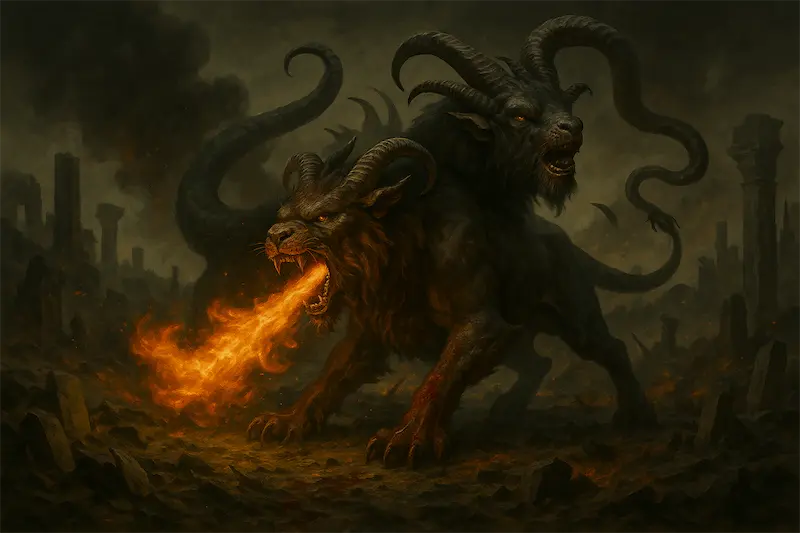Introduction to Chimera
Chimera is one of the most terrifying and fearsome creatures in ancient Greek mythology. The name “Chimera” (Χίμαιρα in Greek) not only refers to this specific monster but has also evolved in modern Western culture into a term describing bizarre, hybrid creatures or fantastical ideas that surpass the limits of human imagination.
In mythology, Chimera is depicted as a monstrous hybrid, combining parts of various animals: the head and body of a lion, a goat’s head protruding from its back, and a tail that is either a serpent or dragon, capable of spewing deadly venom. Chimera symbolizes chaos, a challenge to natural order, and represents dangers beyond human control.
Chimera appears in many ancient literary works, most notably in Homer’s Iliad, where it is described as a creature sowing death and destruction across Lycia until the hero Bellerophon, aided by Pegasus, slays it.
Appearance and Characteristics of Chimera
Grotesque Appearance
Chimera is a fusion of three of the most powerful animals, creating not only a grotesque appearance but also granting it combined, overwhelming strength:
- Lion’s head and body: Representing brutal strength, dominance, and unmatched predatory instincts.
- Goat’s head on its back: Symbolizing stubbornness, aggression, and madness. In some legends, the goat head can also breathe fire.
- Serpent or dragon tail: Signifying malice and lurking danger that strikes from behind.
Most notably, Chimera possesses the ability to breathe fire, making it a devastating force capable of destroying villages, fields, and spreading terror among the people of Lycia.
Aggressive Behavior
Chimera is an extremely aggressive, bloodthirsty creature driven by a desire to destroy and kill. It attacks all living beings indiscriminately, including its own kind. Its chaotic and uncontrollable nature makes it a severe threat to both mortals and gods alike.
Origins and Symbolism of Chimera
Mythological Origins
Chimera is the offspring of Typhon and Echidna—known as the “parents of monsters” in Greek mythology. With pure monster blood, Chimera inherits all the cruelty, strength, and chaotic tendencies of its lineage.
It resided in Lycia (modern-day Turkey), where it devastated lands, killed people, and threatened local civilizations until the hero Bellerophon was tasked to slay it.
Symbolic Meaning
Chimera is more than just a hybrid creature; it is the embodiment of chaos and unnatural mutation. It symbolizes humanity’s deepest fears of monstrous deformities, dangerous experiments, abnormal hybrids in science, and out-of-control, mad ideas.
In modern culture, the term “Chimera” is used to describe genetically engineered creatures, artificial beings, or speculative concepts—often carrying warnings of the uncontrollable risks such creations might pose.
Physical Traits and Powers of Chimera
Physical Strength
- Muscular power from the lion part: With the strength and physique of a lion, Chimera boasts incredible bite force and agility, capable of crushing warriors, destroying chariots, and smashing through fortifications.
- Fire-breathing ability: Chimera’s most dangerous weapon, allowing it to incinerate enemies from afar and reduce entire villages to ashes.
- Venomous serpent tail: The serpent tail delivers a deadly bite, with venom potent enough to kill even giants.
Speed and Endurance
Chimera is described as extremely fast, difficult to outrun or avoid. Its thick, armor-like hide renders it nearly immune to conventional weapons.
Famous Myths and Legends About Chimera
The Battle with Bellerophon
Chimera’s most famous story is its battle with the hero Bellerophon. Tasked by King Iobates of Lycia to kill the beast, Bellerophon mounted Pegasus and attacked from the air, avoiding Chimera’s lethal attacks.
He speared a lead-tipped lance into Chimera’s throat as it opened its mouth to breathe fire. The intense heat melted the lead, which poured into its throat, burning it from the inside and killing it. This feat made Bellerophon one of the greatest heroes in Greek mythology.
Influence of Chimera in Modern Culture
Literature, Film, and Games
Chimera remains a powerful symbol in modern pop culture:
- In literature and films, Chimera appears in Dante’s Inferno, Fullmetal Alchemist, Percy Jackson, God of War, and many others, symbolizing chaos, wild power, and dangerous experiments.
- In video games, Chimera often appears as a formidable boss, combining deadly skills and grotesque forms to challenge players.
- In science and medicine, the term “Chimera” refers to organisms with two sets of DNA or genetic hybrids, often serving as ethical warnings about the consequences of reckless scientific ambition.
Similar or Opposing Mythical Creatures
Similar Creatures
Chimera shares similarities with other hybrid monsters like the Hydra or Cerberus, which also combine multiple animal traits and heads.
Opposing Creatures
Chimera represents chaos and madness, standing in stark contrast to creatures like the Unicorn or Phoenix, which symbolize purity, order, and rebirth.
Chimera in Feng Shui
As a creature of chaos and negative energy, Chimera is generally unsuitable as a feng shui symbol. However, some modern feng shui theories suggest that Chimera’s imagery could be used as a powerful talisman to guard against dark forces or hidden dangers—but placement and use must be done cautiously to avoid unintended negative effects.
Conclusion
Chimera is a powerful symbol of chaos, unnatural fusion, and dangers beyond human control. From ancient Greek mythology to the present day, its image continues to haunt the human imagination as a warning of the consequences of extreme ambition, reckless experiments, or uncontrollable ideas. Despite its terrifying nature, Chimera remains a strong source of inspiration in art, culture, and science fiction, reminding us to respect the boundaries of nature and human capability.
